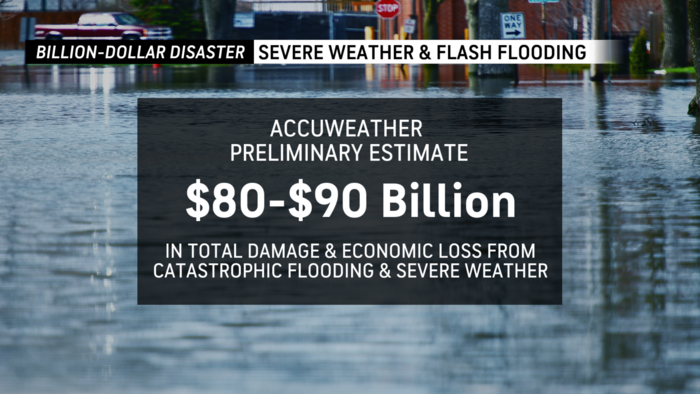 |
|---|
Source: AccuWeather news release
State College, PA — AccuWeather Global Weather Center – April 7, 2025 – A rare atmospheric river that funneled extreme rainfall into the central United States, combined with a multiday severe weather and tornado outbreak over the same region due to a series of slow-moving storms, caused an estimated $80 billion to $90 billion in total damage and economic loss, according to a preliminary estimate from experts at AccuWeather.
This is a preliminary estimate, which considers what has already occurred as well as additional flooding impacts expected over the next week. The full effects of flash flooding, tornadoes, hail and damaging wind gusts are continuing to be felt. Some areas have not yet reported information about damage, injuries or other impacts. Water is still rising in some communities as rivers receive water that has runoff from creeks and streams in recent days. Major river flooding will continue in some areas for days to come, unfortunately resulting in additional risk to lives and property.
“A rare atmospheric river continually resupplying a firehose of deep tropical moisture into the central U.S., combined with a series of storms traversing the same area in rapid succession, created a “perfect storm” for catastrophic flooding and devastating tornadoes,” AccuWeather Chief Meteorologist Jonathan Porter said. “We’re heartbroken by the loss of life and destruction from this once-in-a-generation storm. Houses and businesses were destroyed by tornadoes. Homes and vehicles were swept away by fast-moving floodwaters. Bridges and roadways were washed out or destroyed in some areas. Travel, commerce and business operations were significantly disrupted.
“It will take years for some of the hardest-hit communities to recover. AccuWeather experts warned of the risk for major flooding earlier and with better descriptions of the impacts than other known sources, and we are confident that those warnings saved many lives and helped people to best prepare for an incredibly dangerous setup.”
AccuWeather’s preliminary estimate of total damage and economic loss of $80 billion to $90 billion accounts for damage to homes and businesses, disruptions to commerce and supply chain logistics, impacts to shipping operations at major hubs, financial losses from extended power outages, major travel delays, as well as damage to infrastructure.
AccuWeather expert meteorologists say the atmospheric river, thunderstorms moving over the same areas and rounds of downpours unleashed 8-16 inches of rainfall and even higher localized amounts around 20 inches in communities over a widespread area across Arkansas, Missouri, Mississippi, Tennessee, Kentucky, Illinois and Indiana from April 2 to April 6, triggering extreme flash flooding. Homes, apartment complexes and businesses across the region have been damaged or destroyed by flooding.
Water damage is particularly costly to repair and is often not covered by homeowner’s insurance policies. Many people are often underinsured for flood damage. An estimated 4 percent of homeowners in the U.S. have flood insurance through the National Flood Insurance Program (NFIP), although the uptake in the NFIP program tends to be higher in communities along waterways, such as rivers, where some of the flooding has occurred in this event.
Roads and railroad tracks across the region have been damaged, even washed away in some spots, by the force of fast-moving and rising floodwaters. The damage, until repaired, can have long-lasting impacts on commerce routes and shipping logistics in the region.
There have been nearly 90 reports of tornadoes since the start of April. At least three tornadoes have been preliminary rated as EF3 or stronger, with winds of 136 mph or higher, in Arkansas, Missouri and Tennessee. The number of tornado reports will likely increase throughout the week as additional damage surveys are completed.
AccuWeather expert meteorologists say hailstones as large as 3 inches or more in diameter and wind gusts up to 100 mph also caused damage during the rare, multiday severe weather outbreak.
AccuWeather incorporates independent methods to evaluate all direct and indirect impacts of the storm, includes both insured and uninsured losses and is based on a variety of sources, statistics and unique techniques AccuWeather uses to estimate the damage. It includes damages to property, job and wage losses, crops, infrastructure, interruption of the supply chain, auxiliary business losses and flight delays. The estimate also accounts for the costs of evacuations, relocations, emergency management and the extraordinary government expenses for cleanup operations and the long-term effects on business logistics, transportation and tourism as well as the long-term and short-term health effects and the medical and other expenses of unreported deaths and injuries.
AccuWeather is the trusted source for total damage and economic loss estimates for weather disasters in the United States. Our recognized experts incorporate independent methods to evaluate all direct and indirect impacts of extreme weather events. In 2017, AccuWeather first issued a widely quoted preliminary estimate for total damage and economic loss during catastrophic flooding from Hurricane Harvey along the Gulf Coast, which helped people in the impacted area, and across the country to better understand the magnitude of the disaster.
This is the third preliminary estimate for total damage and economic loss that AccuWeather experts have issued so far this year, outpacing the frequency of major, costly weather disasters since AccuWeather began issuing estimates in 2017.
In late January, AccuWeather experts issued a preliminary estimate of total damage and economic loss of $14 billion to $17 billion for a historic winter storm that brought snow, freezing temperatures and major disruptions to the Gulf Coast and southeastern U.S. AccuWeather experts estimate that historic and deadly wildfires that swept through communities across Los Angeles County, California, in early January caused $250 billion to $275 billion in damages.
“AccuWeather experts estimate that extreme weather and natural disasters in the United States so far this year have caused a staggering $344 billion to $382 billion in total damage and economic loss,” Porter said. “Hurricanes, tornadoes, wildfires, flooding and other extreme weather events caused more than $500 billion in total damage and economic loss across the U.S. last year, according to AccuWeather estimates. There is no doubt that the frequency and severity of extreme weather in America is escalating. More people, businesses and communities are feeling the direct impacts, which are being fueled by a warming climate.”
Porter said it is critical that severe weather preparedness remains a top priority.
“The impacts of extreme weather are taking a major financial toll on families, businesses, local governments and first responders. AccuWeather estimates that weather disasters have already caused $344 billion to $382 billion in total damage and economic loss so far this year, and we are still months away from the peak of hurricane and wildfire seasons. Resources and finances are being strained,” Porter explained. “Disaster fatigue is a growing issue in America. It is crucial that everyone stays connected and is prepared for the likelihood of additional extreme weather events throughout the year. AccuWeather’s superior accuracy is proven to save lives, prevent injuries and protect property. AccuWeather’s track record of weather forecasting and warnings has saved more than 12,000 lives, prevented injury to over 100,000 people and saved companies tens of billions of dollars through better planning and decision making.”
Porter encourages people to review their insurance policies and flood insurance options.
“Extreme weather is worsening the insurance crisis in America. It is becoming more expensive and sometimes more difficult for families and businesses to secure insurance coverage, especially in high-risk areas,” Porter explained. “Many Americans have little or no insurance coverage for flooding. It’s important that everyone know the risks where they live and the options they have for flood insurance, especially before the start of hurricane season.”
About AccuWeather, Inc. and AccuWeather.com
AccuWeather, recognized and documented as the most accurate source of weather forecasts and warnings in the world has saved tens of thousands of lives, prevented hundreds of thousands of injuries and tens of billions of dollars in property damage. With global headquarters in State College, PA and other offices around the world, AccuWeather serves more than 1.5 billion people daily to help them plan their lives and get more out of their day through radio, television, newspapers, smart phones, tablets, connected TVs, the AccuWeather Network and AccuWeather.com. Additionally, AccuWeather produces and distributes news, weather content, and video for more than 180,000 third-party websites.
 |
|---|


